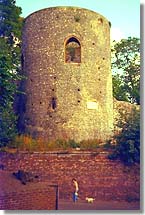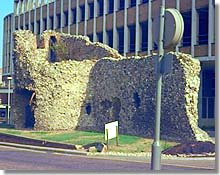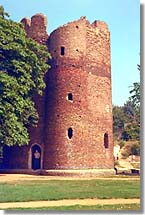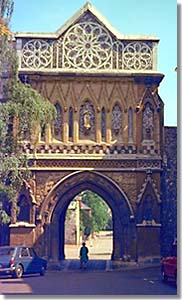In order to consolidate the growing control over its own
administration, the city had to face challenges from a variety of
rivals in the areas of legal jurisdiction and economic matters.
To a community becoming increasingly
conscious of its social and political "personality", it was intolerable
that its physical personality be so vaguely defined. The first step in
remedying this was to delineate the city limits. At some time during
Stephen's reign the boundary of Westwyk was indicated by a ditch, and that
of southern Conesford by a gate on Berstrete and a few decades later by
another gate on Southgate; the latter may have been a response to
territorial claims of Carrow Abbey, founded south of the town in 1146. In
1235 the city was fined for attempting to assert its jurisdiction in common
fields outside the hundredal limits
of Norwich. Although we don't know where those fields were exactly,
they may have been in the southwestern quadrant of the city that the
citizens made a point of taking in, when the king gave them licence to
enclose the city, in 1253, with a ditch and nine gates. This ditch swept
in a wide arc, connecting Westwyk and southern Conesford and advancing
into Taverham hundred in the north. It represented a territorial claim,
and one that was challenged both by country-dwellers (who complained that
their old paths had been blocked) and by the cathedral priory, which
accused the city of illegally enclosing lands belonging to itself, Carrow
Abbey, and rural hundreds.
Undaunted, the citizens consolidated this coup by building a stone wall
along the same boundary. The importance of boundaries, in terms of
control over territories and commerce, is seen in that wall-building was
an expensive and long-term undertaking. To finance it, the city obtained
royal grants of murage in 1297,
1305, 1317, and 1337. On the last occasion they
farmed the murage to
citizen Richard Spynk, who also contributed out of his own wealth to
ensure the completion of the walls – in return for generous concessions
by the city. Although there was provision for artillery and portcullises,
it would be a mistake to think of these walls as exclusively defensive in
purpose. The length of their line, the poor quality of construction,
and the disinclination of the citizens to keep it in repair, together with
the fact that the eastern boundary had no wall (only the river as a
barrier), meant that they would not be a real obstacle to any serious
attacker. As part of Spynk's contract with the city, the latter was
required to take steps to prevent abuse of the walls, such as by
citizens hanging cloths to dry on them. By the 1370s, however, the city
itself was leasing out the defensive towers for commercial uses, such as
milling. Despite this, the walls were an expression of city pride and
independence, intended to channel trade into and out of the city at set
points where tolls could be collected (which explains the anger of the
country people in 1253, no longer able to evade those payments).



Norwich fortifications
[left] The southernmost element of the wall, watching down from the
top of Carrow Hill,
was this large tower, which came (in the 15th century) to be called
the Black Tower.
[centre] A western stretch of wall and tower just south of
St. Stephen's Gate
[right] On the bank of the Wensum, where it looped southwards
around the meadow
of the Great Hospital, the Prior had
a tower, probably related to collecting tolls on
river-bound traffic, but also used as a prison. In 1378 this was turned
over to the city.
Later used to house cows pastured in the meadow, it acquired the name
"Cow Tower".
photos © S. Alsford
The monks' complaint in 1253 was prompted by other reasons. It was part
of an ongoing defense against the encroachments of the citizens. From
early in the century there had been a number of points of contention
between city and cathedral-priory. Not all of the lands given to the
cathedral priory were enclosed by the cathedral precinct wall; the
Prior's Fee included a number of
areas within the city, whose residents (based on
royal grants to the Prior) refused to contribute to taxes imposed on the
city or to acknowledge any authority of city officers over them. The
city tried to claim jurisdiction over the inhabitants of those areas,
countering the monks' accusations with those of its own. In 1244 one
issue was settled when it was agreed the Prior's tenants would contribute
£20 towards the fee farm
(£100 at this time). In 1249-50 the city complained that the
Prior was taking "holy-day" tolls on bakers and other citizens, but
the Prior successfully defended that this was a customary right. In
1256/57 the Priory's baker was killed in a quarrel with a citizen
and, since he had died on the Priory grounds, the city bailiffs
were denied permission to hold the inquest. The same year saw
a conflict over the Prior collecting
landgable, while the following year
saw the bailiffs assaulted by a party of monks and their servants in a
jurisdictional dispute over a piece of property.
All this came to a head in the summer of 1272 when the citizens erected
a quintain (a target for lance practice) on Tombland, in a location
probably chosen to annoy the monks. A quarrel broke out with servants
of the Priory, who were forced to retreat, but one of the servants shot
a citizen with a crossbow. After an inquest, the city coroners arrested
two priory servants, following which the Prior excommunicated and
interdicted the citizens. By August things had reached a state of siege,
with the Priory gates closed and its servants taking potshots at citizens
from behind the walls. An attempt to negotiate a peaceful settlement
when the Prior refused to endorse an agreement. Instead he brought in
three barges full of armed men from Yarmouth, which had its own reasons
for enmity with Norwich. These and the Priory
servants sallied forth into the city at night: killing one man, wounding
others, robbing, looting and burning. Despatching a complaint to the
king, the city authorities called for a muster of citizens in the
marketplace the following morning (August 8th or 9th). An attack was
then made on the Priory; one of its gates was burned down to effect an
entry into the precinct and a church immediately within was looted and
burned. The fire spread to other buildings, even to the cathedral
(although the damage was much exaggerated in the subsequent legal
proceedings); 13 defenders were killed – some in formal execution
style – while others were taken off to prison, and the attack
disintegrated into general plundering of cathedral treasures. It
was not a total rout, however, for the following day the Prior, William
de Brunham, himself killed one of his opponents.
Within a week the king was taking action, despatching commissions to
bring matters under control and ordering the sheriff and the constable
of the castle to assist the commissioners. In September he set out for
the city in person to supervise the investigation; arriving on September
14, he subsequently placed both city and Priory under wardens. The
accused included citizens who had played leading roles in local
government. Following the trial at least 29 were hanged. A further
investigation in December reached the conclusions that the fault in
the affair lay with the Prior's violence against the city, and that
the fire in the church had been an accident of smiths employed by the
Priory; Brunham was arrested and turned over to his bishop to be tried
(but his punishment was light). In 1275 the affair was finally settled
through arbitration by the king, who set damages payable by city to
Priory at £2000, in return for which the excommunication was
lifted from the city. Arguments between the two sides continued,
however, and eventually the king urged them to a compromise (1306),
which conceded the city much of the jurisdiction it wanted.
 Ethelbert Gate
Ethelbert Gate
One of the two principal gates leading from Tombland into the cathedral
close (the other built ca.1420 by Sir Thomas
Erpingham), the Ethelbert Gate was built in the early 14th century at
the cost of the citizens as part of a settlement with the cathedral, and
particularly in recompense for the burning down of St. Ethelbert's church
during the 1272 riot. Perhaps its carving of St. George and the dragon is
an allegory on the event?

photos © S. Alsford
Encouraged by this success, the citizens immediately turned their attention
to the waste-land in the borough, which
belonged to the king. This land had developmental potential which
represented annual rents for the city treasury. In 1307 Norwich
petitioned the king for a grant of all the waste-land ... and was refused.
So the citizens did what was commonly done in other boroughs and built on
the land anyway, accumulating rents adding up to £9.11s.8d annually
by 1329, when the royal escheator demanded these rents be handed over to
the king. An appeal to the king, however, produced a decision in the
citizens' favour, conceding them the waste-land.
Their next target was the Castle Fee,
an area encompassing not only the
castle but an expanse of surrounding land housing many persons, under
castle rather than city jurisdiction. The citizens resented this
exempt jurisdiction in the midst for much the same reasons as they did
that of the Prior's Fee: the lay inhabitants might profit from city
liberties without being liable to the obligations of citizenship, and
they might commit crimes in the city and then seek sanctuary of the Fee,
where they could obtain trial from a favourably-disposed jury of their
fellows. There was also the potential physical threat, exemplified during
the barons' wars: in 1264 men from the castle threatened the city
coroners so that they could not complete inquests, and burned down the
house of a citizen.
In 1344, the citizens took advantage of the king's presence in Norwich
to plead their case. Investigation revealed to Edward that the castle
was of no military value and that a grant of the Fee would mean only a
very minor loss in revenue, since most revenues would continue to come
to him through an (inevitable) increase in the city's fee farm. So in
1345, he transferred to the city all but castle, shirehouse (the seat
of the county court), and their immediate enclosure. This area was not
integrated with adjoining leets, but maintained an independent one,
with city bailiffs replacing the sheriff in its court.
A similar series of rivalries is seen in economic affairs, as the city
sought to monopolize trade and control the conditions under which it
took place. The first step in the process was to obtain the right to
exact tolls on merchandize passing through the city gates, as well as
freedom for the citizens from paying such tolls in other boroughs. The
latter was one of the grants in the 1194 charter. The former was not
explicitly granted but was probably implicit in that charter's grant to
Norwich of all customs valid in London. In 1305 the citizens obtained
a more specific list of tolls from which they were exempt.
Naturally, the right to take tolls and the exemption from tolls
elsewhere – which the king granted to many towns – worked against each
other. Merchants from other towns coming to Norwich might claim to be
exempt from Norwich's tolls, while Norwich merchants might face demands
from towns they visited that they pay tolls there. The 1194 charter
therefore granted that, should toll be illegally taken from a Norwich
citizen and the offending town refuse to compensate, Norwich's reeve
could exact the amount due from
the goods of any merchant of the offending town found in Norwich. Again,
since this was a common grant to towns, it only exacerbated the situation,
leading to arguments, reprisals, and counter-reprisals. A further round
of royal grants (in Norwich's case, in 1255) specified that no citizen's
goods should be seized elsewhere in relation to any debt for which they
were not the debtor or guarantor, except in the case where the citizen
was a member of a community which has refused to give satisfaction to
the legitimate claims of a creditor. This was in tune with the medieval
concept of every burgess sharing in the rights and obligations of his
peers. But it did not help merchants whose goods might be seized through
no fault of their own. Sometimes it was probably easier to avoid
arguments with the officials of other towns, and just pay the tolls
demanded. But then the capitulating merchant might be fined by his own
leet court, for setting a precedent
prejudicial to the chartered liberties of the city. The consequence of all
this was to foster feelings of hostility between towns; particularly if
foreign towns were involved, there could be political repercussions not
to the liking of the king. Eventually the king banned the reprisal
mechanism.
Norwich's concern to regulate local trade is clearly seen in its
custumal (the collection of local
laws). Many of the customs were devoted to rules of fair trade: equal
opportunity trading for every citizen; no
trading privately outside the
market, nor before the ringing of the cathedral bell for the mass of
the Virgin; no citizen was to assist a non-citizen avoid paying toll
(for example, by pretending the latter's merchandize was his own);
payment on the spot for goods bought from country-dwellers. The
bailiffs duties included regular examination of the weights and measures
of taverners, brewers, and other merchants, to ensure their accuracy;
none was valid unless stamped with city seals intended for that purpose.
Once the problems associated with administrative jurisdiction were settled
(by 1346) and after recovery from the effects of the Black Death (with
property values rising again), efforts towards strengthening control over
trade were redoubled. A special tax was levied in 1378 to buy up
shops and market stalls, and it was then ruled that meat and fish could
be sold only from these stalls. Similarly, two quays were acquired in
1379 and designated as the only legitimate places for loading and unloading
goods; incoming goods of visiting merchants had to be stored in a
community-owned warehouse while in the city. A new list of tolls was
drawn up. In 1384 a large building just north of the market-place was
acquired; part was converted into a Common Inn, where visiting merchants
had to lodge, another part into the Worsted Seld, the only place from
which country weavers could sell their worsted cloth to the citizens.
Norwich's wealth in the late Middle Ages was founded primarily upon the
cloth industry, especially manufacture of worsteds, a fine cloth sold
throughout England and exported to the continent. When an inventory
of city property was made, in 1397, it was quite extensive.
Part of the effort in controlling trade was directed at reorganizing the
craft gilds. As rivals for
control of trade conditions, craft gilds were at first suppressed
by Norwich authorities. Besides fixing wages, prices and standards
of manufacture, the gilds also deprived city courts of revenues from
fines, by settling quarrels between members through internal
arbitration. The 1256 royal charter included a clause outlawing gilds,
and tanners, fullers, saddlers and cobblers were fined by the leet
courts in the 1280s and '90s for having gilds. But by the second half of
the fourteenth century it had become clear that suppression was ineffective;
it gave way to a policy of recognition combined with supervision. An
addition to the custumal authorized the
bailiffs and city council to appoint annually a few members of each
craft to act as wardens and check, several times a year, on the conduct
of the city craftsmen; any fraudulent practices or defective work were
to be reported to city authorities to act on. In the first half of the
fifteenth century further steps were taken to control the gilds, climaxing
in a lengthy set of ordinances (1449) by which gilds were to be governed.
In the area of trade, there were other rivals over which the city had
less control. One source of dispute between monks and citizens was
the fair rights on Tombland. The 1306 compromise mentioned above
conceded the citizens first choice of which part of Tombland they
would use for their stalls. The citizens also resented the Prior's right
to hold a piepowder court (a
speedy dispute-resolution process for travelling merchants) during the
fair; in 1380 city authorities jealously ruled that any citizen taking
a case to the Prior's court would be deprived of citizenship. Norwich
petitioned to have its own piepowder court in 1443; although this was
granted a few years later, there is no sign they ever went ahead and held
one.
The Merchants of the Staple represented another independent jurisdiction,
via the law-merchant. Norwich was one of a handful of staple towns
(exclusive ports for the export of wool) during the reigns of Edward II
and Edward III. In 1353 a royal statute set up organizations in those
towns, each headed by a Mayor of the Staple, whose court had sole
jurisdiction over foreign merchants and cases of debt, trespass, or
breach of contract involving their members. However, since Norwich's
staple organization was dominated by its own merchants, there was probably
no serious conflict here.
Norwich's role as a staple was one factor in a long-standing rivalry with
Great Yarmouth, which was made staple town in 1369 in place of Norwich.
However, the hostility really went back to the question of which town
was the port having right to exact tolls on boats using the Wensum. As
early as 1257 Norwich complained that Yarmouth was stopping ships from
coming upriver and forcing the merchandize on board those ships to be
sold in its own market. This would mean a loss of some of the revenues
Norwich needed to pay its fee farm. An argument of that nature was
always guaranteed to be persuasive to the king. Renewed complaints in
1333 prompted a royal mandate to Yarmouth bailiffs to desist. By this
time Yarmouth appears to have captured enough of the disputed commerce
to have become wealthier than Norwich.
Rivalries such as those described above played their part in the
historical process which brought Norwich to the point of
incorporation. The conflicts
revealed to city authorities the need to strengthen their powers,
and incorporation represented the highest expression of privileges
that might be attained by local government of that time. A burning
sense of identity and local pride is revealed by these conflicts, as well
as by general distrust of any outsider (the difference in breadth of
outlook between those times and ours being illustrated by the fact that
to the medieval townsmen a "foreigner"
was anyone living outside the borough, while someone from parts we today
would classify as foreign was termed an
"alien").
The impulses towards incorporation, from the borough's point of view,
were a tangled web of circumstances reacting upon themselves. Gaining
control of the fee farm may have brought a degree of political
independence, but it did not profit the borough financially. Decreasing
revenue from tolls, as the result of royal grants of exemption, and from
rents (which remained at a fixed level), in the face of mounting costs
as the size of bureaucracy grew, public properties needed maintenance,
and city walls were built – on top of annual payment of the fee farm as
well as frequent royal taxes, made things difficult financially for the
city. Traditional revenues became inadequate to meet the fee farm, and
so that had to be given first call on new revenues. In 1305 the king
gave the bailiffs the power to levy local taxes. It became clear that
property-holding was the likeliest cure for the city's economic ills;
yet the lack of a formal existence in the eyes of the law was a
hindrance to this. The 1404 charter remedied that.
A reflection of the improvement of city fortunes and the crystallization
of the spirit of community is seen in the development of record-keeping.
Norwich's first century of independence saw the appearance only of
"records of necessity": court proceedings, financial accounts, and
registration of deeds to property. In the decades following the
completion of the walls and acquisition of the Castle Fee we see
the commencement of a Book of Memoranda (memorabilia concerning the city,
later used for enrolling the names of new citizens), the drawing up of
a new version of the custumal, the recording of proceedings of the
city council, and the inventorying of city property. All this reflects
growing self-confidence and maturity.
In many ways, the thirteenth and fourteenth centuries were the heyday
of medieval Norwich (and other boroughs). We see signs of a deep
satisfaction with living in urban communities, and expressions of
civic patriotism and a sense of all-for-one and one-for-all. Yet, as
the fourteenth century wore on, the idea of the common good was losing
its hold and, partly as a result of the trend towards incorporation
(which, from the king's point of view, was an attempt to impose a certain
uniformity on his boroughs), new forces of self- and class interest
came to the fore to undermine the notion of
community in the borough.


 History of
medieval Norwich
History of
medieval Norwich


 Ethelbert Gate
Ethelbert Gate


